-
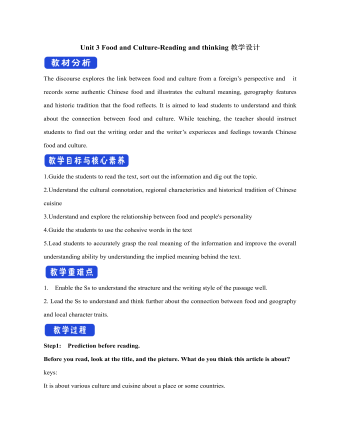
新人教版高中英语选修2Unit 3 Food and Culture-Reading and thinking教学设计
The discourse explores the link between food and culture from a foreign’s perspective and it records some authentic Chinese food and illustrates the cultural meaning, gerography features and historic tradition that the food reflects. It is aimed to lead students to understand and think about the connection between food and culture. While teaching, the teacher should instruct students to find out the writing order and the writer’s experieces and feelings towards Chinese food and culture.1.Guide the students to read the text, sort out the information and dig out the topic.2.Understand the cultural connotation, regional characteristics and historical tradition of Chinese cuisine3.Understand and explore the relationship between food and people's personality4.Guide the students to use the cohesive words in the text5.Lead students to accurately grasp the real meaning of the information and improve the overall understanding ability by understanding the implied meaning behind the text.1. Enable the Ss to understand the structure and the writing style of the passage well.2. Lead the Ss to understand and think further about the connection between food and geography and local character traits.Step1: Prediction before reading. Before you read, look at the title, and the picture. What do you think this article is about?keys:It is about various culture and cuisine about a place or some countries.
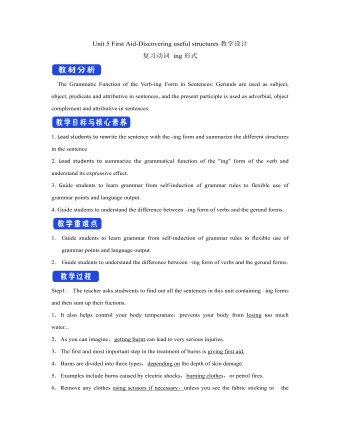
新人教版高中英语选修2Unit 5 First Aid-Discovering useful structures教学设计
You have no excuse for not going.你没有理由不去。He was punished for not having finished his homework.他因未完成作业而受到惩罚。2.动词ing形式复合结构由物主代词或人称代词宾格、名词所有格或普通格加动词ing,即“sb./sb.'s+doing”构成。动词ing形式的复合结构实际上是给动词ing形式加了一个逻辑主语。动词ing形式的复合结构有四种形式:①形容词性物主代词+动词ing②名词所有格+动词ing③代词宾格+动词ing④名词+动词ingHer coming to help encouraged all of us.她来帮忙鼓舞了我们所有人。The baby was made awake by the door suddenly shutting.这个婴儿被突然的关门声吵醒了。Can you imagine him/Jack cooking at home?你能想象他/杰克在家做饭的样子吗?无生命名词无论是作主语还是作宾语都不能用第②种形式。Tom's winning first prize last year impressed me a lot.汤姆去年得了一等奖使我印象深刻。Do you mind my/me/Jack's/Jack leaving now?你介意我/杰克现在离开吗?Excuse me for my not coming on time.很抱歉我没能按时来。His father's being ill made him worried.他父亲病了,他很担心。We are looking forward to the singer's/the singer to give us a concert.我们盼望着这位歌手来给我们举办一场演唱会。
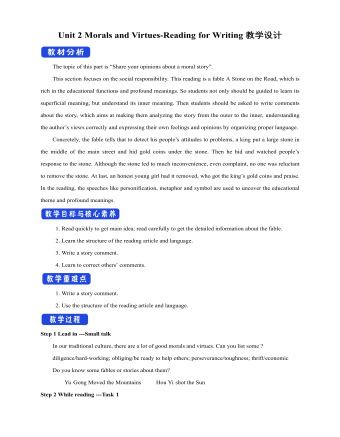
新人教版高中英语必修3Unit 2 Morals and Virtues-Reading for Writing教学设计
1. 这个寓言是一个关于一位国王古寓言。 The fable is an old fable about a king.2.作者用这个故事让读者对于社区的问题负有个人责任的必要印象深刻。The author used the story to impress upon readers with the need to take personal responsibility for problems in the community.3. 这个故事十分成功的实现了它的目的。The story was quite successful in achieving its purpose.Step 7 WritingPlease write a review of the story according the outline above.The fable is an old fable about a king who thought his people are lazy, so he put a large stone in the middle of the road and hides and waited to see if anyone will try to move it.The author used this story to impress upon readers with the need to take personal responsibility for problems in the community. The story was quite successful in achieving its purpose, and I liked it because it had a clear moral.However, while the moral of the story is clear, the actions of the king seemed pointless to me, because none of the characters in the story learnt anything. For this reason, I think there are better stories that can be used to impress upon people with the need for personal responsibility.Step 8 Pair workExchange drafts with a partner. Use this checklist to help your partner revise his/her draft.1. Does the writer give a short description of the story ?2. Does the description include the most important details of the story ?3. Does the writer give his or her opinion about the character or their actions ?4. Is the review well-organised ? 5. Does the writer use the -ing form as the adverbial correctly in the writing ?6. Are there any grammar, spelling, or punctuation errors ?Step 9 HomeworkPut up your revised draft in the classroom or read it to your class.
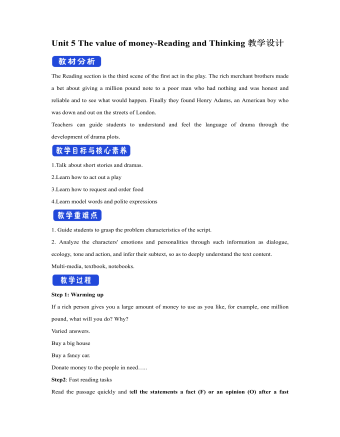
新人教版高中英语必修3Unit 5 The value of money-Reading and Thinking教学设计二
? Could you offer me some kind of work here?? I don’t want your charity, I just want an honest job.? Careless: I landed in Britain by accident.Step 7:Consolidation.? Find Henry? Roderick and Oliver were I .making a bet when they saw Henry, a poor young man. ? Know Henry? About a month ago, Henry was sailing and later he found himself carried out to sea by a strong wind. Fortunately, he 2.was spotted by a ship. And it was the ship that brought him to 3.England? Offer money to Henry ? Oliver and Roderick gave Henry a letter and told him that there was money in it. They 4.persuaded him to accept it, and made him 5.promise that it wouldn't be opened until 2 o'clock.Step 8:Language pointsa large amount of: a large quantity of; a great deal ofe.g. They bought a large amount of furniture before they moved their new house.make a bet: make an arrangement to risk money, etc. on an event of which the result is doubtful.e.g. We made a bet on the result of the match.permit sb to do something: allow somebody to do somethinge.g. My mother doesn’t permit me to ride in the street after it rained.by accident: as a result of chancee.g. I only found it by accident.stare at: look at somebody or something with the eyes wide open in a fixed gaze( in astonishment, wonder, fear, etc)to be honest: to tell you the truth; to be franke.g. To be honest, I don’t think we have a chance of winning.Step7 Homework:What do you think will happen to Henry? Will the bank-note help him or get him into trouble?
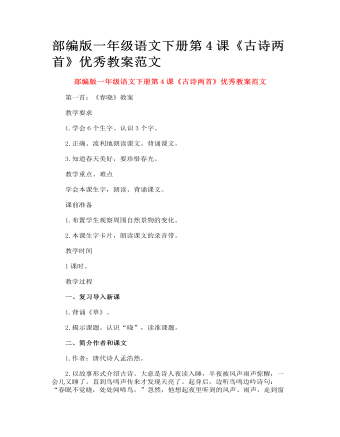
部编版一年级语文下册第4课《古诗两首》优秀教案范文
指导写字 觉:“学”下面的的“子”换成“见”。 夜:第四笔是“竖”,不要写成“竖钩”。注意指导笔顺,提示不要漏写第七笔“点”。可与熟字“衣”比较字形的异同。 雨:仿佛隔窗观雨。里面左右各两点,上下排列,像檐下滴水。 声:上面是“士”,不是“土”。下面的最后一笔是“丿”,不是“竖弯钩”,不能写成“巴”。 知:左边是把“午”的“竖”改撇,再加一点。右边是“口”表示知道了要用口说出来。 少:上面与“小”不同,第一笔是竖,没有钩。
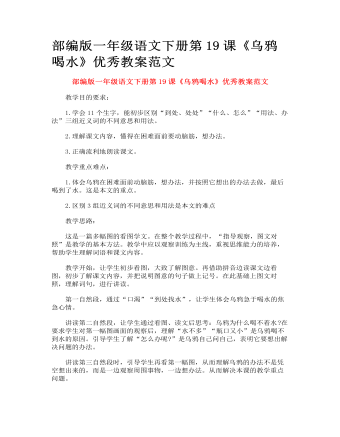
部编版一年级语文下册第19课《乌鸦喝水》优秀教案范文
教学思路: 这是一篇多幅图的看图学文。在整个教学过程中,“指导观察,图文对照”是教学的基本方法。教学中应以观察训练为主线,重视思维能力的培养,帮助学生理解词语和课文内容。 教学开始,让学生初步看图,大致了解图意。再借助拼音边读课文边看图,初步了解课文内容,并把说明图意的句子做上记号。在此基础上图文对照,理解词句,进行讲读。 第一自然段,通过“口渴”“到处找水”,让学生体会乌鸦急于喝水的焦急心情。 讲读第二自然段,让学生通过看图、读文后思考:乌鸦为什么喝不着水?在要求学生对第一幅图画面的观察后,理解“水不多”“瓶口又小”是乌鸦喝不到水的原因。引导学生了解“怎么办呢?”是乌鸦自己问自己,表明它要想出解决问题的办法。 讲读第三自然段时,引导学生再看第一幅图,从而理解乌鸦的办法不是凭空想出来的,而是一边观察周围事物,一边想办法。从而解决本课的教学重点问题。
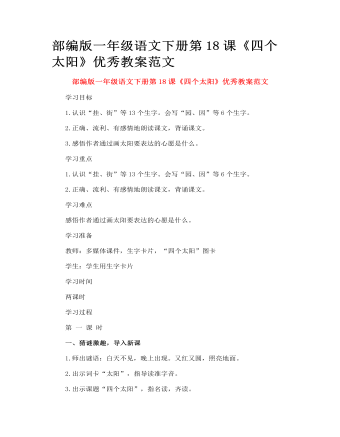
部编版一年级语文下册第18课《四个太阳》优秀教案范文
猜谜激趣,导入新课 1.师出谜语:白天不见,晚上出现。又红又圆,照亮地面。 2.出示词卡“太阳”,指导读准字音。 3.出示课题“四个太阳”,指名读,齐读。 4.引导质疑:读了课题,你的小脑瓜里是不是蹦出了小问号? 二、初读课文,认记生字 1.出示课件:带拼音生字,指名带读。 2.出示课件:去拼音生字并打乱顺序,摆字卡,自由练习朗读。 3.游戏:我说你找喊名字。 4.指导识记生字方法。 5.巩固游戏:我把生字送回家。动画演示,指导写字 1.猜谜引入:大口框里有个“大” 2.出示课件:“因”书写笔顺规则 看了动画,你知道了什么? 3.出示课件:“园” “园”与“因”哪里长得很像?书写的时候要注意些什么?(同样先里面后封口) 4.师范写“园”“因”,讲解书写要领。 5.生自由练写,师巡回指导。 6.集体评价。
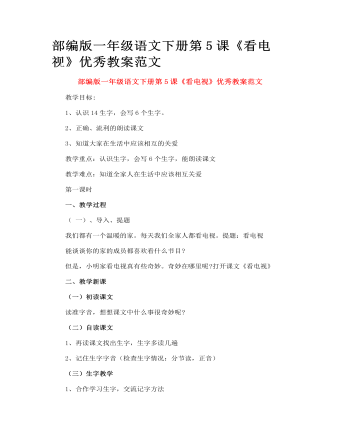
部编版一年级语文下册第5课《看电视》优秀教案范文
教学新课 (一)初读课文 读准字音,想想课文中什么事很奇妙呢? (二)自读课文 1、再读课文找出生字,生字多读几遍 2、记住生字字音(检查生字情况:分节读,正音) (三)生字教学 1、合作学习生字,交流记字方法 2、出示词语巩固生字 (四)写字教学 “全家”两字教学 (五)读懂课文 1、 再读课文,读懂后让你上来排顺序 爸爸和我———足球迷 奶奶———京剧 听的入迷 打盹睡觉 爸爸和我———足球 乐的直叫 一起拍手欢 妈妈 ———音乐 舞蹈 2、 找出把足球赛转成京剧的小节? 爸爸再看球赛时想到了什么? 3、 结果奶奶听的入迷,我和爸爸都在打盹睡觉。 奶奶又怎么想了呢? 找出京剧换成足球这一节?
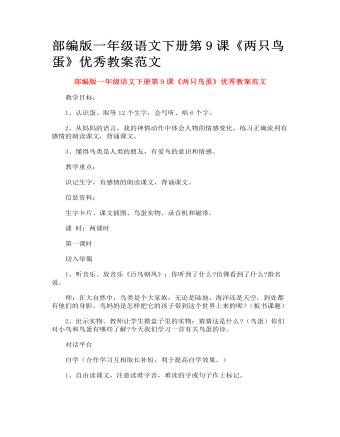
部编版一年级语文下册第9课《两只鸟蛋》优秀教案范文
朗读(读说思议练结合,培养学生语文综合能力。) 1、学习第一小节: (1)指名读,回忆刚才摸鸟蛋的感觉(小小的、凉凉的)体会着读一读。 (2)比较“鸟蛋凉凉的”和“凉凉的鸟蛋”:你发现了什么?(引导学生发现这类词语的特点:词序不同,但表达的意思相同。)除了凉凉的鸟蛋还有什么是凉凉的? (3)你还能像这样再说几个吗? (如果学生说不出来,教师可进行指导,把写有“花儿、小草、柳枝、大海,红红的、绿绿的、软软的、蓝蓝的”的词语卡分给学生,让拥有不同词语的学生去找朋友,再让两个朋友变换左右顺序。) 2、学习第二小节: (1)轻声读文,思考:你怎么知道两只鸟蛋就是两只小鸟? (2)出示小鸟破壳的图片或课件,引导学生说一说。 (3)启发想象:鸟妈妈焦急不安是什么样?你能表演一下吗? 表演后试着把妈妈的语气读出来。 (4)你还能用焦急不安说句话吗?看谁说得和别人不一样?
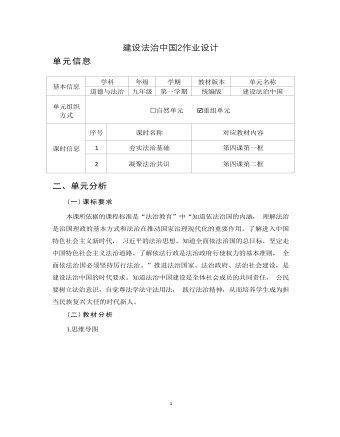
九年级上册道德与法治建设法治中国2作业设计
6.新冠肺炎疫情发生以来,中央强调,在疫情防控工作中,要坚决反对形式主义、 官僚主义, 让基层干部把更多精力投入到疫情防控第一线。这样要求 ( )①有利于政府工作人员依法行政②有利于政府履行职责,维护广大人民群众的根本利益③有利于形成良好的社会风气④警示人类必须坚持走可持续发展的道路A. ①②③ B. ①②④ C. ①③④ D. ②③④ 7.中央纪委监察部网站(现中央纪委国家监委网站)开通纠正“四风”(形式主义、 官僚主义、 享乐主义和奢靡之风) 监督举报直通车,引导网友积极举报各种公款 吃喝、公款旅游等“四风”问题。这一做法 ( )①扩大了我国公民的政治经济权利②有利于政府依法行政,实现国家长治久安③有利于提高我国公民的民主监督意识④有利于国家机关及其工作人员勤政廉洁A. ①②③ B. ①②④ C. ①③④ D. ②③④ 8.《孟子 ·离娄上》有言:“徒善不足以为政, 徒法不能以自行。”
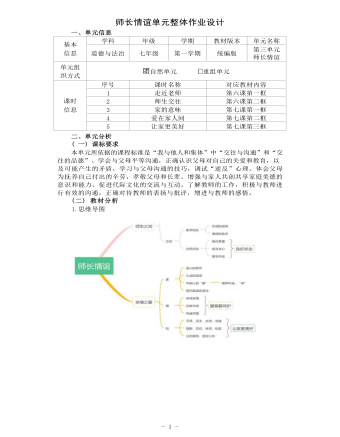
初中道德与法治七年级上册师长情谊作业设计
(2) 请你结合上述两幅漫画,对这一行为进行简要评析。15.某校七年级组织学生以“孝亲敬长”为主题开展手抄报评比活动。下面是某 同学手抄报的部分内容,请你阅读并参与完成相关问题。[我的感受]在人世间,最美的旅行是回家。无论走得多远,每个游子的心里也都有一个 归家的梦!回家的感觉真好!(1) 结合所学的知识,分析说明“回家真好”的原因是什么?[我的思考]调查显示:在当今家庭中,许多孩子不要父母过多干涉他们的学习和生活, 很多同龄人有被父母偷看过 QQ、微信聊天记录和日记的经历……(2) 针对调查显示的问题,你认为应怎样做才能处理好亲子之间的冲突?[我的鉴赏]人生最美好的事,莫过于我长大,你未老。我有能力报答,你仍然健康。父 母之爱,儿女即使用一辈子也是报答不完的。
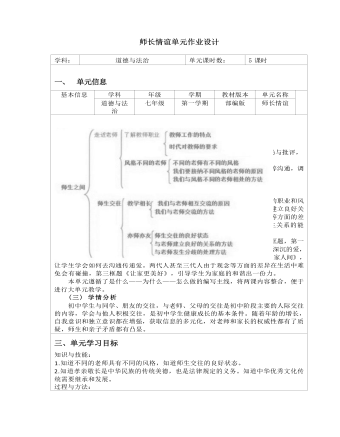
初中道德与法治七年级上册师长情谊4作业设计
作业 2:老师在与我们的交往中,扮演着组织者、倾听者、陪伴者的角色。作为学生,我 们要正确对待老师的表扬和批评。下列对此认识正确的是 ( )①老师的表扬意味着肯定、鼓励和期待②老师的表扬和批评能激励我们更好地学习和发展③老师的批评意味着关心、提醒和劝诫,可以帮助我们改进不足④对待老师的批评,我们要理解老师的良苦用心A.①②③ B.①③④ C.②③④ D.①②③④1.参考答案:D2.时间要求:2 分钟3.评价设计:本题学生错题的原因在于没有正确理解老师的批评和表扬。 4.作业分析与设计意图:本题考查如何正确看待老师的批评和表扬。(1) 老师的表扬意味着对我们的肯定、鼓励和期待;批评意味着老师对我们的关心、 提醒和劝诫,可以帮助我们改进不足,对待老师的批评,我们要理解老师的良苦用心。 (2) 老师的表扬和批评能激励我们更好地学习和发展,我们要正确地对待老师的表 扬和批评,被老师表扬不骄傲,受到批评也不气馁和抱怨,正视老师的教育,从而促 进良好师生关系的发展。
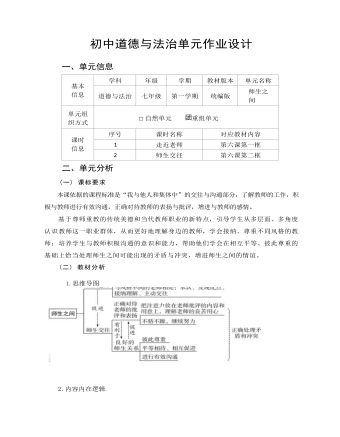
初中道德与法治七年级上册师生之间作业设计
第六课“师生之间”是七年级上册第三单元第一课。本课基于初中学生自我意识 增强、思维能力发展的特点,着力处理青春期的独立性与依赖性的矛盾,帮助学生深 入认识和理解自己的老师。在感受老师对自己的关爱和教育的同时,学会主动关心、 帮助老师,与老师建立一种良好的师生关系。本课与第七课“亲情之爱”内容继承了 孝亲敬长的中华传统美德,落实了社会主义核心价值观的基本内容,指引学生正确处 理师生关系、亲子关系和家庭关系,是初中学生人际交往的拓展与延伸。第一框“走近老师”,从教师的职业特点和责任使命等角度,引导学生进一步了解 老师,理解老师的不易,培养尊敬老师的情感,学会积极接纳不同风格的老师,为学 习第二框的内容奠定情感基础。第二框“师生交往”,引导学生懂得“教学相长”的道理,强调师生之间的双向互动,引导学生正确对待老师的引领和指导,全面认识师生交往的实质,努力建立和谐 的师生关系,达到师生交往理想而美好的状态。
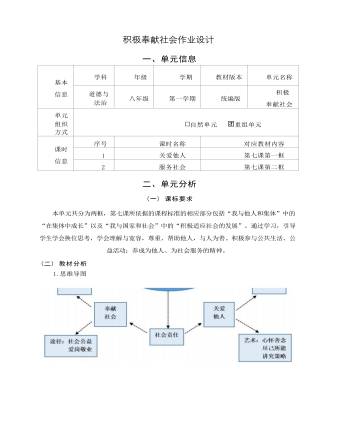
道德与法治八年级上册积极奉献社会作业设计
②服务和奉献社会需要我们青少年担当责任;服务和奉献社会需要我们积极参与社会 公益活动;服务社会,需要我们热爱劳动,爱岗敬业。答具体途径也可,如:环境保 护、社区服务、参加义务植树等。5.①我认为上述观点是正确的。②志愿服务可以体现人生价值,促进我们的全面发展。 一个人的价值不应该看他得到什么,而应该看他贡献什么。只有积极为社会做贡献, 才能得到人们的尊重和认可,实现自身价值。③通过开展志愿服务,承担社会责任, 可以发掘自身潜能,才能承担起时代和国家所赋予我们的使命,共享美好幸福生活。 ④在志愿服务的行动中,心怀善意、尽己所能、讲究策略的关爱他人,可以培养亲社 会行为,营造向上向善的社会和谐氛围。⑤服务社会的根本在于学习和践行。我们应 该从小事做起,从现在做起,在学习和实践中积极承担社会责任。⑥综上所述,志愿 服务正能量,勇担责任助成长。崇德向善新风尚,学习践行不能忘。
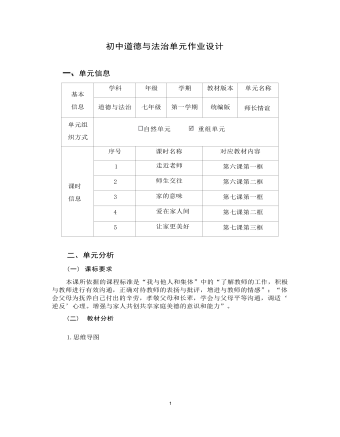
初中道德与法治七年级上册师长情谊9作业设计
2.内容内在逻辑承接上一单元中学会和同伴交往,本单元则是帮助学生正确处理师生关系、 亲子关系和家庭关系,是人际交往的继续和延伸。师长是中学生成长中的“重要他人” ,学生和师长的关系如何,直接影响到学 习和生活的质量。到了青春期以后,随着青少年自我意识的凸显,他们要求摆脱 依赖、走向自立的愿望和行动增强,有时会和师长产生冲突。教材不回避青少年 成长可能带来的各种冲突与矛盾,在尊重学生的独立愿望、成长需要的基础上, 引导他们走近师长,看冲突背后“爱”的流动,通过主动对话和交流达成相互理解。第六课第一框题 主要是在情感上引导学生去主动了解老师、 尊重老师、 亲近老师; 乐于接纳并尊重不同风格的老师。能够以恰当的方式表达对老师的情感;学会接纳不同风格的老师;提高提炼信息和语言表达的能力。了解教师的 工作特点,理解教师工作的特殊性;理解存在不同风格教师的原因;知道不同的 教师具有不同的风格。
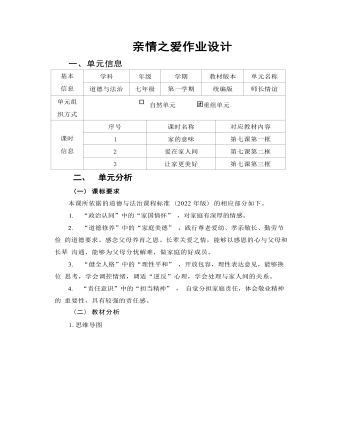
初中道德与法治七年级上册亲情之爱2作业设计
(一) 课标要求本课所依据的道德与法治课程标准 (2022 年版) 的相应部分如下。1. “政治认同”中的“家国情怀” ,对家庭有深厚的情感。2. “道德修养”中的“家庭美德” ,践行尊老爱幼、孝亲敬长、勤劳节俭 的道德要求。感念父母养育之恩、长辈关爱之情,能够以感恩的心与父母和长辈 沟通,能够为父母分忧解难,做家庭的好成员。3. “健全人格”中的“理性平和” ,开放包容,理性表达意见,能够换位 思考,学会调控情绪,调适“逆反”心理,学会处理与家人间的关系。4. “责任意识”中的“担当精神” , 自觉分担家庭责任,体会敬业精神的 重要性,具有较强的责任感。(二) 教材分析1.思维导图2. 内容内在逻辑第七课《亲情之爱》是七年级上册第三单元第二部分内容。在介绍与同学、 朋友、老师交往的基础上,要求学生认识、了解家庭,学会与家人交往。
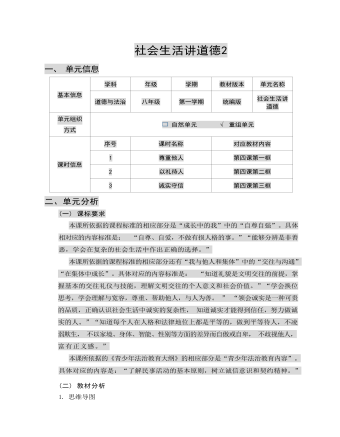
道德与法治八年级上册社会生活讲道德2作业设计
(一) 课标要求本课所依据的课程标准的相应部分是“成长中的我”中的“自尊自强”。具体 相对应的内容标准是: “自尊、自爱,不做有损人格的事。”“能够分辨是非善 恶,学会在复杂的社会生活中作出正确的选择。”本课所依据的课程标准的相应部分还有“我与他人和集体”中的“交往与沟通” “在集体中成长”。具体对应的内容标准是: “知道礼貌是文明交往的前提,掌 握基本的交往礼仪与技能,理解文明交往的个人意义和社会价值。”“学会换位 思考,学会理解与宽容,尊重、帮助他人,与人为善。 ” “领会诚实是一种可贵 的品质,正确认识社会生活中诚实的复杂性, 知道诚实才能得到信任,努力做诚 实的人。”“知道每个人在人格和法律地位上都是平等的,做到平等待人,不凌 弱欺生, 不以家境、身体、智能、性别等方面的差异而自傲或自卑, 不歧视他人, 富有正义感。”

道德与法治八年级上册社会生活讲道德作业设计
2. 内容内在逻辑本课由引言和三框内容组成。引言首先指出道德是社会关系的基石,是人际和谐的基础,说明本课与单元主题之间的关 联 。随后,点出本课的三个主题:尊重他人、以礼待人、诚实守信。第一框“尊重他人”,用学生常见的两个场景引导体验,导入新课 。学生在理解尊重含义的 同时,懂得尊重对个人和社会的价值和意义,懂得尊重的复杂性;进而引导学生学会如何在实 际生活做到尊重他人。第二框“以礼待人”,引导学生探讨文明有礼对个人和社会的意义,再扩展至“礼仪之邦”的 国家形象,懂得参加各种仪式体现了民族的尊严和国家的形象。第三框“诚实守信”,首先使学生明白诚信是一种道德规范,也是社会主义核心价值观在公 民个人层面的一个价值准则,在学生体会和认识到诚信对个人、社会等重要影响的基础上,引 导学生不断增强诚信意识,积极参加诚信建设。
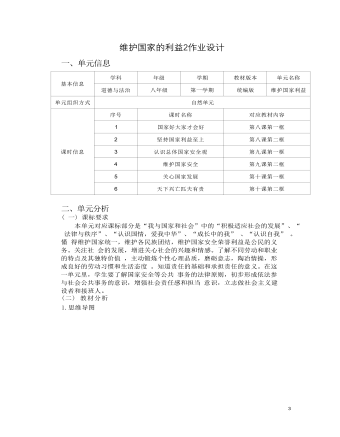
道德与法治八年级上册维护国家利益2作业设计
2. 内容内在逻辑第八课《国家利益至上》设计了“国家好,大家才会好”“坚持国家利益至 上”两框内容,其立意在于帮助学生认识维护国家利益的重要性,正确认识国家 利益与人民利益的关系,提高维护国家利益的意识,树立正确的国家利益管,提 高辨析各种爱国观念和行为的能力,使自己的爱国情感更加理性、深沉。第九课《树立总体国家安全观》设计了“认识总体国家安全观”和“维护国 家安全”两框。 目的在于引导学生正确理解和全面把握我国安全形势面临的挑战 ,从小树立总体国家安全观, 自觉担负起维护国家安全的责任。第十课《建设美好祖国》设计了“关心国家发展”“天下兴亡,匹夫有责” 两框内容,其目的和意图在于帮助学生全面认识国家发展,从初中学生的角度认 识祖国发展,正视国家发展过程中的问题,理解自己与国家发展的密切关联,让 学生在关心祖国发展的同时,为将来投身于国家建设奠定认识基础。

道德与法治八年级上册网络生活新空间作业设计
5. 当今世界,日新月异的互联网不仅促进了社会生产力的新变革,而且创造 了人类生活新空间。下列属于网络推动社会进步的表现的是( )① 网络让我们日常生活中的信息传递和交流变得方便迅捷② 网络为经济发展注入新的活力,推动传统产业转型升级③ 网络丰富民主形式,促进民主政治进步④ 网络为文化传播和科技创新搭建新平台A.①③④ B.②③④ C.①②④ D.①②③④二、非选择题?6. “互联网"让浙江农业有了别样面貌。信息经济在浙江腾飞, 赋予了这片土地上的农民格外活跃的互联网思维。他们开网店卖农产 品,红红火火。浙江的“互联网+”农业还远不止把农产品搬到网上。 越来越多的农民在土地上播撒下互联网种子,捕捞那跳跃的数字,用 它指导生产、提高亩产。互联网让农民有了不一样的面貌,更让现代 农业有了全新的模样。(1) 互联网对经济发展起到了怎样的促进作用?(2) 互联网的快速发展还在哪些方面产生了影响?








